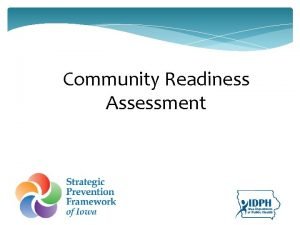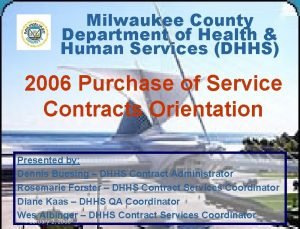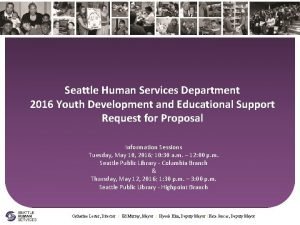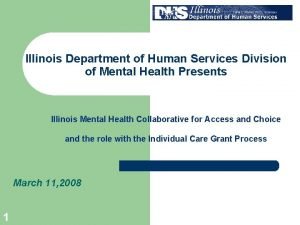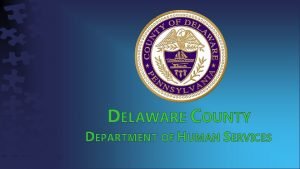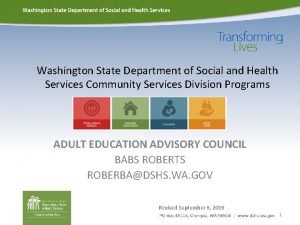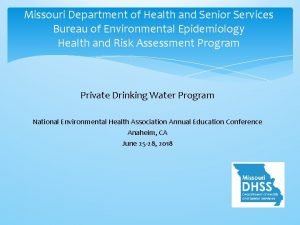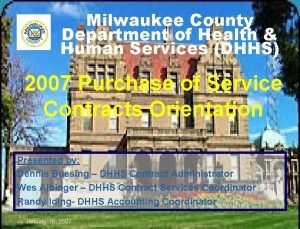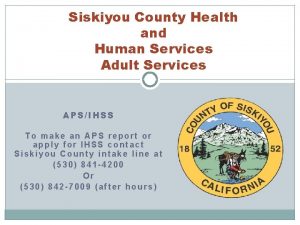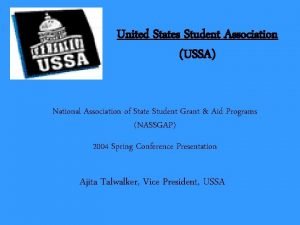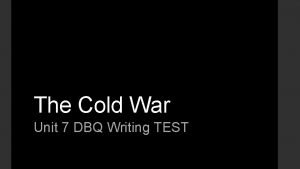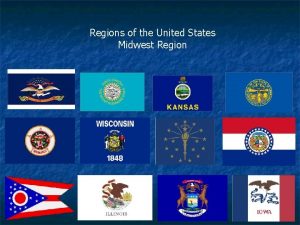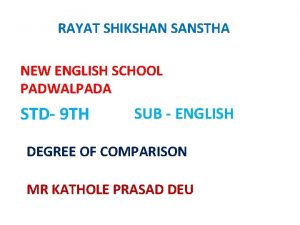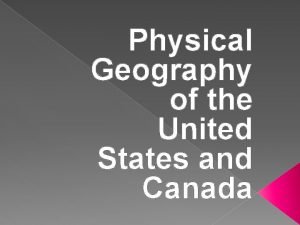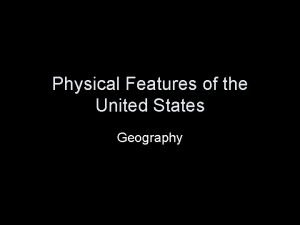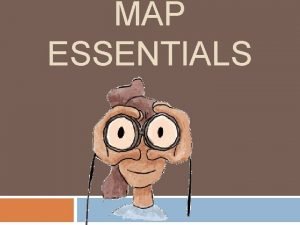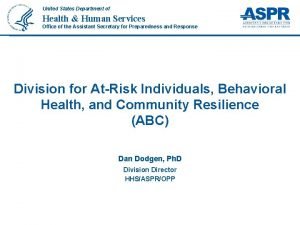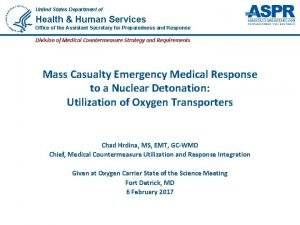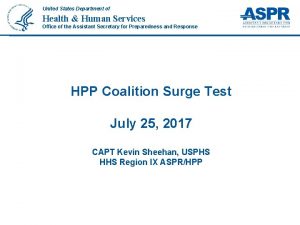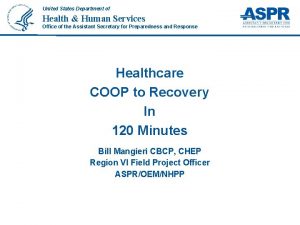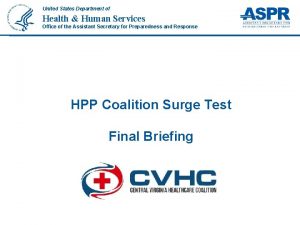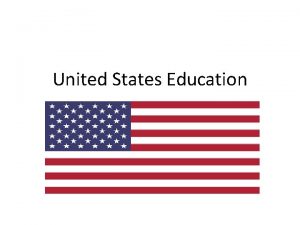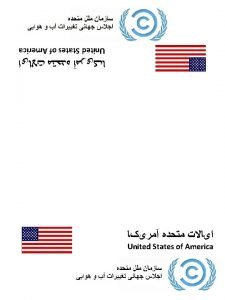United States Department of Health Human Services Office






































- Slides: 38

United States Department of Health & Human Services Office of the Assistant Secretary for Preparedness and Response Federal Patient Movement Ken Hopper Federal Patient Movement Coordinator Operations Division Office of Emergency Management Office of the Assistant Secretary for Preparedness and Response

Acronyms • • • APOE: Aerial Port of Embarkation APOD: Aerial Port of Debarkation ARF: Action Request Form BARDA: Biomedical Advanced Research and Development Authority (BARDA) DMAT: Disaster Medical Assistance Team DMORT: Disaster Mortuary Operational Response Team EMAC: Emergency Management Assistance Compact EMG: Emergency Management Group ESF: Emergency Support Function FCC: Federal Coordinating Center FMS: Federal Medical Station IRCT: Incident Response Coordination Team • • • • MA: Mission Assignment MRC: Medical Reserve Corps NDMS: National Disaster Medical System NRF: National Response Framework NSSE: National Special Security Event NTSB: National Transportation Safety Board PAHPA: Pandemic and All Hazards Preparedness Act PHE: Public Health Emergency PHS: US Public Health Service PSOW: Pre-scripted Statement of Work RDF: Rapid Deployment Force REC: Regional Emergency Coordinator SOC: Secretary’s Operation Center ASPR: Resilient People. Healthy Communities. A Nation Prepared.

NDMS Partners A federal sector partnership HHS Do. D VA DHS A Nationwide Medical Response System to: § Supplement State and local medical resources during disasters or major emergencies § Provide backup medical support to the military / VA medical care systems during a military health emergency ASPR: Resilient People. Healthy Communities. A Nation Prepared.

Components of NDMS 1 2 Medical Response Lead HHS Patient Evacuation Lead Do. D / HHS Definitive Care Lead Do. D/VA Do. D Aeromedical Evacuation Primarily Fixed Wing Do. D/VA Federal Coordinating Centers HHS DMAT NMVT IMSu. RT DMORT 3 Specialty Teams ASPR: Resilient People. Healthy Communities. A Nation Prepared.

Patient Evacuation Primary: Do. D / HHS • Provide Patient Movement from the • • disaster area; air, bus, train Utilize all types of transportation ESF#8 Patient Movement Coordination Cell manages and staffs requests Primarily relies on aeromedical USTRANSCOM: Patient regulating, movement requests, staging, tracking ─ Embarkation ─ Debarkation ASPR: Resilient People. Healthy Communities. A Nation Prepared. 5

AE Operations Definitive Care DASF / MAC T at APOE FCC at APOD Patients from area hospitals, nursing homes ASPR: Resilient People. Healthy Communities. A Nation Prepared.

National EMS Contract (aka FEMA Ambulance Contract) • FEMA contract executed through HHS operational support • Can only be utilized within a Stafford Activation/Declaration 7 ASPR: Resilient People. Healthy Communities. A Nation Prepared.

Quick Facts • Centrally managed, regionally coordinated contract • Provide a full array of licensed ground, air ambulance • • and para-transit services to assist states in accomplishing patient evacuation May be ordered as needed to supplement response to a disaster, act of terrorism or other public health emergency. State public health authorities determine there are unmet requirements to rapidly and safely evacuate patients with complex and ongoing medical needs; Initiate request for federal assistance; First zone in 24 hours or less; second zone in 48 hours. ASPR: Resilient People. Healthy Communities. A Nation Prepared. 8

Performance Requirements Per Zone • GROUND AMBULANCE ─ 300 ground ambulances (ALS & BLS) ─ Typically a 70%/30% ALS/BLS split • AIR AMBULANCE ─ 25 air ambulances, helicopter and/or fixed wing • PARA-TRANSIT ─ Ability to transport 3, 500 individuals ─ Not 3, 500 vehicles BOTTOM LINE: LIMITED NUMBER OF RESOURCES ASPR: Resilient People. Healthy Communities. A Nation Prepared. 9

Contract Zones ASPR: Resilient People. Healthy Communities. A Nation Prepared. 10

EMS Roles • In addition to the ground air assets, there approximately 150 EMTs (EMT-Basic and Paramedic) ─ ─ ─ ─ ─ Patient triage, treatment & transport Conducting well-ness checks (aka “door-to-door missions”) Staffing shelters Distributing immunizations Hazard recognition Symptom surveillance & reporting On-scene medical standby Staffing emergency departments Setting up mobile medical units ASPR: Resilient People. Healthy Communities. A Nation Prepared. 11

Patient Tracking ASPR: Resilient People. Healthy Communities. A Nation Prepared.

Joint Patient Assessment and Tracking System (JPATS) • Needed a way to track Grandma when moved in the • • Federal Patient Movement system, from start to finish “FEDEX” for patients Web based application ─ Do. D legacy system – Joint Patient Tracking Application ─ Easy to use; minimum training requirements • One leg of the HHS disaster IT triad that makes up Disaster Medical Information Suite ─ JPATS ─ Electronic Medical Record ─ Health Information Repository ASPR: Resilient People. Healthy Communities. A Nation Prepared. 13

State Patient Tracking System Challenge Source: ASPR Regional Emergency Coordinator ASPR: Resilient People. Healthy Communities. A Nation Prepared. 14

Components of NDMS 1 2 Medical Response Lead HHS Patient Evacuation Lead Do. D / HHS Definitive Care Lead Do. D/VA Do. D Aeromedical Evacuation Primarily Fixed Wing Do. D/VA Federal Coordinating Centers HHS DMAT NMVT IMSu. RT DMORT 3 Specialty Teams ASPR: Resilient People. Healthy Communities. A Nation Prepared.

Definitive Medical Care Primary Lead: VA / Do. D • Approximately 1, 882 civilian hospitals in the NDMS network nationwide ─ Agree to make a number of inpatient beds available • Beds categorized into 5 categories (burn, critical care, medsurg, psych, and pediatric) ─ Heavy focus on trauma care • Federal Coordinating Centers (FCCs) ─ ─ Concentrated in major metropolitan areas Air access Available hospital support Patient reception and distribution capabilities ASPR: Resilient People. Healthy Communities. A Nation Prepared. 16

ASPR: Resilient People. Healthy Communities. A Nation Prepared.

Definitive Medical Care • Service Access Teams ─ Follow patients to the NDMS facilities (track in JPATS) ─ Ensure transportation, human services (language translation, food, lodging, etc) and arrangements for discharged patients and attendants ─ Coordinate patient return ASPR: Resilient People. Healthy Communities. A Nation Prepared. 18

Federal Patient Movement Limitations and Gaps ASPR: Resilient People. Healthy Communities. A Nation Prepared.

Current Parts and Pieces • • HHS ─ Mobile Acute Care Strike Team ─ Service Access Team ─ Joint Patient Assessment and Tracking System (JPATS) Team Do. D ─ Disaster Aeromedical Staging Facility (DASF) ─ Global Patient Movement Integration Center (GPMIC) / TRAC 2 ES ─ Tactical Airlift Control Center (TACC) / Fixed-winged airlift ─ FCCs / Patient Reception Area VA ─ FCCs / Patient Reception Area ─ Litter teams Other ─ NDMS Hospitals ─ National Ambulance Contract ASPR: Resilient People. Healthy Communities. A Nation Prepared. 20

Limitations/Gaps • Feds can only move limited number of patients with • limited transport resources. Additional APOEs problematic for AE ─ Do. D will not move: • List of approx 15 no-fly conditions (e. g. , must be 72 hours postop, Seizure with in last 2 weeks, Hgb <8. 5) • Pediatric/neonate patients • True burn patients requiring burn teams to transport • Un-restrained psych patients…require chemical restraints • National Ambulance Contract not the panacea—it is intended to augment state and local resources ASPR: Resilient People. Healthy Communities. A Nation Prepared. 21 21

Timelines ASPR: Resilient People. Healthy Communities. A Nation Prepared. 24

Planning Factors Patient Movement Planning Factors - Laydown: 8 C-130 s; 4 APOEs - C-130 schedule: 2 sorties per day - Average acuity: 20% critical care 35 patients per C-130 Total Patients 1200 Maximum Patient Movement Capability: 560 patients/day 4 APOEs Typical pre-storm start at H-54 = 840 patients evacuated Request to Move Boots on the Ground Evac Ops Cease Redeploy 36 hrs Complete 1000 800 600 400 of patient movement 200 H-72 H-60 Teams Deploy Setup H-48 H-36 Patient Movement Operations H-24 H-18 H-12 Reconstitution 25 H- Hour - Point at which tropical ASPR: Resilient People. Healthy Communities. A Nation Prepared. force storm winds reach landfall 7

“Notice” Incident Gulf Coast Pre-Storm Evac H-24 H-Hour H-48 H-Hour H-72 H-96 Patient Movement operations end at H-120 LA decision to evac patients Patient Movement Cell conference call H-24 H-48 MA approved for NDMS patient movement H-72 26 H-hr – Point at which tropical force storm winds reach landfall FEMA Trigger Pt 1 AE Operations begin Do. D surge mission assignment ASPR: Resilient People. Healthy Communities. A Nation. H-120 Prepared. H-96

“No-Notice” Incident • Timelines compressed—no D-hour. Start at D-0. • Will need patient movement requirements clearly stated. ─ Requires best assessment of number and type of patients needing evacuation; ─ Limitations to where patients are evacuated? Okay to take out of state? ─ Identify APOE(s); for AE, need Do. D to validate APOE. • Do we commit all four APOEs? • Are there alternate modes of transport that can be brought to bear? ASPR: Resilient People. Healthy Communities. A Nation Prepared. 27 27

Gaps… • Need to increase capacity to move patients • Need to build a more responsive federal patient • • movement system Need to improve network of NDMS medical facilities to include long-term care Need pediatric/neonate, and burn solutions ASPR: Resilient People. Healthy Communities. A Nation Prepared. 28

What we are doing… • Is AE the ONLY solution for evacuation? Can “MEDEVAC” fill the gaps? ─ Regulated vs unregulated patients • • Rewriting the Definitive Medical Care MOA for NDMS facilities Working with ONC to look at atypical methods to view bed capacity Developed Medical Evacuation of Patients with Highly Contagious Diseases paper Developing alternate modes of transport ─ Air • • National Guard • U. S. Coast Guard • U. S. Forest Service • General Aviation Ground ─ Better utilize train transport ─ Ground freight movement (e. g. , tractor trailers, ISO containers) ASPR: Resilient People. Healthy Communities. A Nation Prepared. 29

What you can do… • States must exhaust all available resources ─ Pre-established mutual aid agreements ─ State Guard engagement to conduct MEDEVAC missions ─ Utilize all existing EMACs • States will need to “hold the fort” until feds can mobilize ─ May be as long as 72 hours • Plans should consider bringing medical resources in to stabilize infrastructure ASPR: Resilient People. Healthy Communities. A Nation Prepared. 30 30

Comments? ASPR: Resilient People. Healthy Communities. A Nation Prepared. 31

Find Us Online PHE. gov: www. phe. gov/about/OPP/DIHS Facebook: www. facebook. com/phegov PHE. gov Newsroom: www. phe. gov/newsroom You. Tube: www. youtube. com/phegov Flickr: www. flickr. com/phegov Twitter: twitter. com/phegov ASPR: Resilient People. Healthy Communities. A Nation Prepared. 32

Patient Tracking Backup Slides ASPR: Resilient People. Healthy Communities. A Nation Prepared. 33

JPATS Functionality • Step by step registration process • Design leverages touch screen functionality, bar code scanning, and patient photographs for identification 34 ASPR: Resilient People. Healthy Communities. A Nation Prepared.

ESF #8 Patient Tracking “Interoperability” • States and Local areas use a variety of applications to • • track patient movement. These systems should be able to share patient records using standard messages and message transport functionality. A standard needs to be created so all the systems can communicate, while addressing security and consent ASPR: Resilient People. Healthy Communities. A Nation Prepared. 35

ESF #8 Patient Tracking “Interoperability” Components • Standard Message – “What data are we sending? ” ─ A standard message needs to be selected: • Health Level Seven International (HL 7) is the global authority on standards for interoperability of health information technology with members in over 55 countries. • Other projects to create a standard message include the Tracking of Emergency Patients (TEP) message. This message is going through the Oasis standards body. ASPR: Resilient People. Healthy Communities. A Nation Prepared.

ESF #8 Patient Tracking “Interoperability” Components - cont • Message Transport – “How are we sending the message? ” ─ The Office of the National Coordinator of Health IT (ONC) is leading the Health Information Exchange community in adopting Nationwide Health Information Network (NHIN) standards. ASPR: Resilient People. Healthy Communities. A Nation Prepared.

ESF #8 Patient Tracking “Interoperability” Components • Security and Consent – “Does the patient consent to us sharing their data? ” and “Is the receiving system going to protect the record? ” ─ Need to take these two considerations into account. • ONC is addressing these issues through Data Use and Reciprocal Support Agreement (DURSA) ─ The Data Use and Reciprocal Support Agreement (DURSA) is a comprehensive, multi-party trust agreement that will be signed by all NHIN Health Information Exchanges (NHIEs), both public and private, wishing to participate in the Nationwide Health Information Network. The DURSA provides the legal framework governing participation in the NHIN by requiring the signatories to abide by a common set of terms and conditions. These common terms and conditions support the secure, interoperable exchange of health data between and among numerous country. A Nation Prepared. ASPR: Resilient. NHIEs People. across Healthy the Communities. 38

ESF #8 Patient Tracking “Interoperability” Direction • Will work with ONC to ensure that interoperability standards adhere to their direction and Nationwide Health Information Network (NHIN) standards ─ Make the most out of American Recovery and Reinvestment Act (ARRA) of 2009 – HITECH Act Meaningful Use funding. ─ Hospital Adoption ASPR: Resilient People. Healthy Communities. A Nation Prepared. 39

Common State Concerns • Operating System ─ States using variety of DB ─ JPATS runs on Oracle…have My. SQL version • Cost of purchasing OS and associated hardware ─ Annex will be included in implementation guide that shows hardware and software costs ─ Grant funding (e. g. , Hospital Preparedness Program) • Local infrastructure and support concerns ASPR: Resilient People. Healthy Communities. A Nation Prepared. 40
 Iowa department of health and human services
Iowa department of health and human services Milwaukee county health and human services
Milwaukee county health and human services Maine department of health and human services
Maine department of health and human services Why is the united states called a postindustrial economy
Why is the united states called a postindustrial economy Seattle human services department
Seattle human services department Illinois department of human services
Illinois department of human services Delaware county department of human services
Delaware county department of human services Washington state department of social and health services
Washington state department of social and health services Department of health and senior services missouri
Department of health and senior services missouri Louisiana department of health and hospitals
Louisiana department of health and hospitals Wake county human services community services center
Wake county human services community services center Milwaukee county dhhs
Milwaukee county dhhs Ihss siskiyou county
Ihss siskiyou county Barnstable county human services
Barnstable county human services Was the united states on the axis powers or allied powers?
Was the united states on the axis powers or allied powers? Unit 2: the united states and canada worksheet answers
Unit 2: the united states and canada worksheet answers Slave state
Slave state Soccer league hierarchy
Soccer league hierarchy Marshall case
Marshall case United states student association
United states student association The united states ought to provide a universal basic income
The united states ought to provide a universal basic income Preamble to the united states constitution
Preamble to the united states constitution The united states in the caribbean 1776 to 1985
The united states in the caribbean 1776 to 1985 Physical features of the southeast region
Physical features of the southeast region Expansion of the united states of america 1607 to 1853 map
Expansion of the united states of america 1607 to 1853 map Who was nicholas novikov? when did he write this telegram
Who was nicholas novikov? when did he write this telegram Previous owner of spanish cession
Previous owner of spanish cession Awake united states meaning
Awake united states meaning Mapp v. ohio
Mapp v. ohio Why did the united states invade cuba in 1898?
Why did the united states invade cuba in 1898? Chapter 6 lesson 2 guided reading answers
Chapter 6 lesson 2 guided reading answers Midwestern region of the united states
Midwestern region of the united states 7 regions of the united states
7 regions of the united states The united states is the greatest buyer positive degree
The united states is the greatest buyer positive degree United states and canada physical map
United states and canada physical map Major physical features of united states
Major physical features of united states 0 degree latitude
0 degree latitude 50 nifty united states
50 nifty united states Chapter 2 free enterprise in the united states answer key
Chapter 2 free enterprise in the united states answer key
